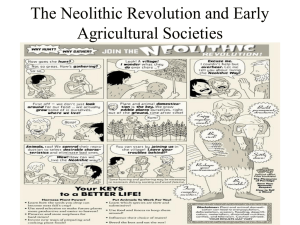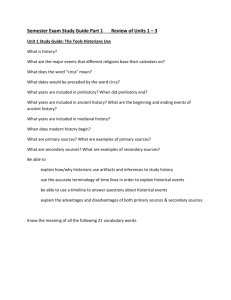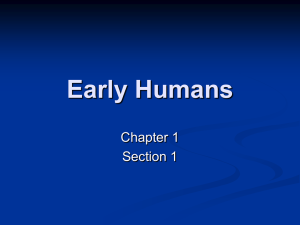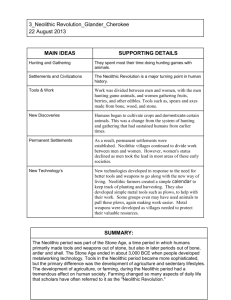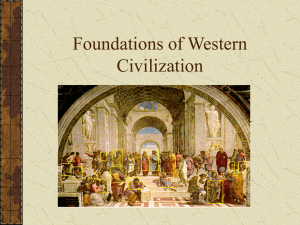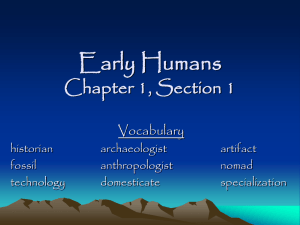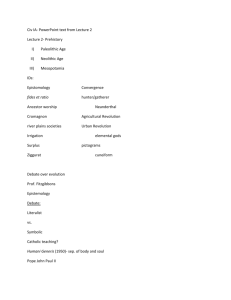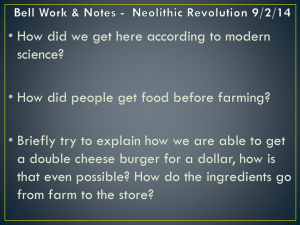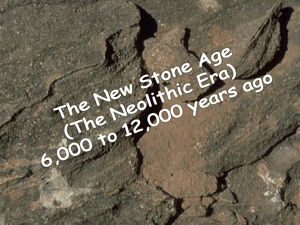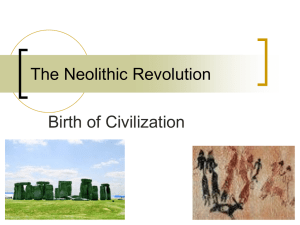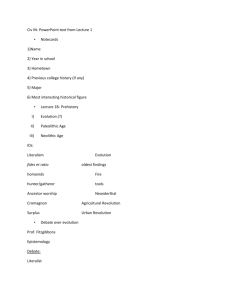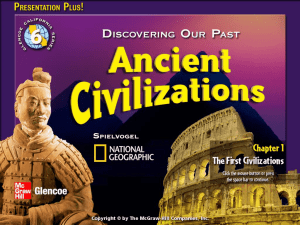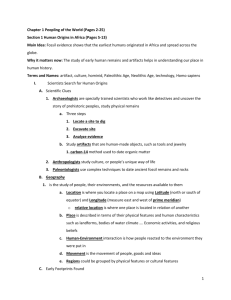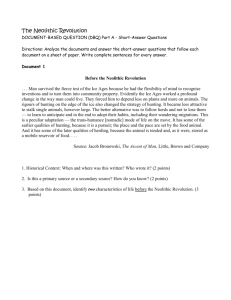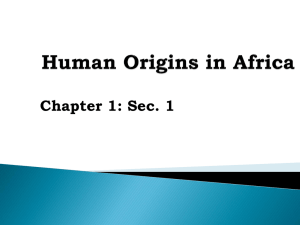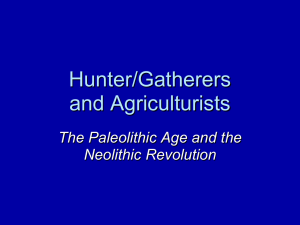Neolithic Revolution (Agricultural Revolution)
advertisement
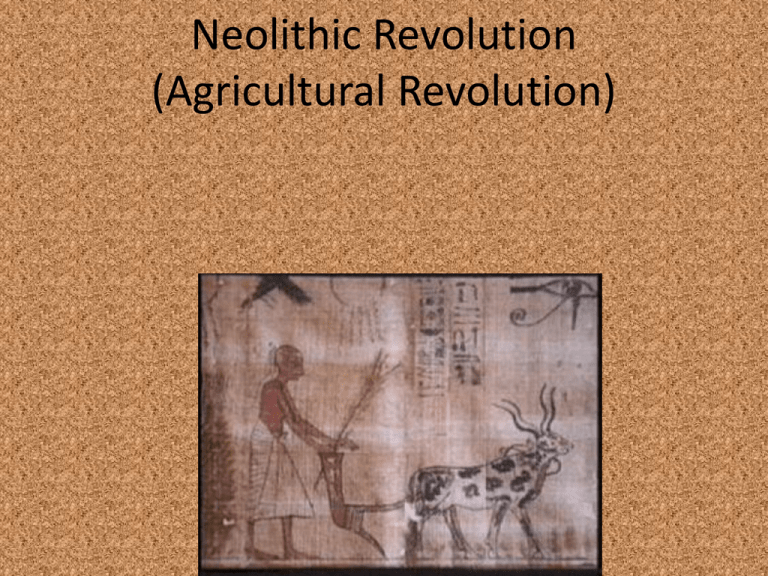
Neolithic Revolution (Agricultural Revolution) Basic Ideas From the Neolithic Revolution • Geographic factors allowed for advances in agriculture that lead to stable food supplies, rising populations, and the development of society Create a Chart Comparing Life Before and After Agriculture Life Before Agriculture Food Supply Shelter Social Structure (government & religion included) Art & Innovation Specialization Language Life After Agriculture Hominids • “Great Apes” • Refers to humans and their ancestors • Australopithecines – 4-1 million years ago • Lucy is the most famous discovery of an Australopithecine. She was found in 1974. A complete, female skeleton dated to 3.5 million years ago Paleolithic Era • Paleolithic means “Old Stone Age” • 2.5 million years ago – 8,000 years ago • People of the Paleolithic Era: – Homo-Habilis (2.5 million – 1.5 million years ago) used simple stone tools “man of skill” – Homo-Erectus (1.6 mil. – 30,000 BC) predecessor to Homo-Sapiens “upright man” • First to use fire, good hunters, and more advanced tools •Neanderthal (200,000BC-30,000 BC) Powerfully built, heavy brows, big muscles Developed some form of religion DNA shows not an ancestor of humans Cro-Magnon • 40,000BC-8,000 BC • These are the earliest Homo-Sapiens “wise man” • Planned hunts, stalked, their population grew at a faster rate as their lives became easier • Probably looked similar to me and you (brain size and capacity were smaller) Life Before Steady Agriculture • People were Hunters and Gatherers • They were Nomadic – travel from place to place in search of food – Once the food in an area was consumed, man moved to a new area – Also followed the migration patterns of animals Shelters Before the Neolithic Revolution • Many nomadic people lived in shelters provided by nature (such as caves) • Many people built very simple shelters made of wood and hides Social Structure • The typical social structure was built around the family • There may have been groups of families together, known as a Clan Art and Innovation • Some drawings and artwork from the Paleolithic Age have been found – Lascaux Cave paintings in France • They used very primitive weapons and tools – Some evidence of sewing needles – The use of fire – Simple stone tools Specialized Labor • The main priority for everyone at this time was finding food • We call this Subsistence Language/Communication • Only verbal communication was used (and it was probably fairly limited/basic) • Symbols were used to mark places of importance NEOLITHIC REVOLUTION • Neolithic means “New Stone Age” – 8,000 BC – 3000 BC • Something very important in the history of the world happens to start the “New Stone Age.” What is it? It changes everything. • Why is this such a big change? How do you think it will change history? Neolithic Revolution • Went from food gatherers to food producers • Now had a steady source of food (what do you think this will lead to?) • Domestication of animals for work and food • The revolution happened independently all around the world at different times Life After Steady Agriculture is Discovered • The Food Supply is the most important factor that changes • People began to plant, tend, and harvest crops • Animals were domesticated for food, and for use as beasts of burden • Hunting was still used, but only to supplement the food supply Sometimes used slash and burn agriculture Shelter After the Neolithic Revolution • Mud bricks are used as a building material • Eventually stones would be quarried, and used as a building material • Villages were located near fields, and other reliable food sources (rivers/seas) Social Structure • Social Structures became more complex, with many clans living in close proximity – What do you think this development will lead to? • Gender separation became more apparent – Men: Farmed, herded, and hunted – Women: Raised the children, cooked, and did jobs near the newly established homes Social Structure (continued) • Governments are developed during this time to organize activity • Religion is developed to help explain nature Art and Innovation • Carving and statuary, complex tools such as advances in weapons, plows pulled by animals, building techniques, cloth making and weaving • Architecture and building for religious or common use Specialization of Labor • Advances in Agriculture lead to more bountiful crops, so some people had to turn to other work (what do you think some of these advances were?) – Some became artisans who made pottery, wove cloth, or made metal tools and weapons • Regional resources were gathered and traded – Trading involved these new products, as well as food – 2 inventions helped expand trade (wheel and sail) Language • Development of pictographic languages (Egyptian Hieroglyphic) or written language. • Developed to keep records concerning food storage & trade. • Cuneiform was developed by Sumerian scribes around 3000 BC (this is where written history begins) Villages Grow into Cities…Civilization Develops • Civilization- Complex culture with 5 characteristics 1) Advanced cities, (2) specialized workers, (3) complex institutions, (4) record keeping, (5) advanced technology Characteristics of Civilization • Advanced Cities – Having a larger population, but also being the center of trade and industry • Specialized Labor – Food surpluses freed up time for people to do other work • Complex Institutions – Religion and Government are examples of these (irrigation, ceremonies, and trade all needed some help) – Social Classes started to be defined according to jobs – Religion was based on things that affected crop rather simply nature or animals Characteristics of Civilization (cont.) • Record Keeping – Taxes, grain collection/storage, yearly rituals, and merchants tracking debts/payments/transactions • Advanced Technology – The Bronze Age (mixing copper and tin to create tools, weapons, and art from bronze) – Irrigation, farming techniques, etc. First Civilizations • Sumer is the first region to show signs of civilization; Ur is the first major city to appear in Sumer (on the Euphrates) • Hit their peak around 3000 BC • Economy was based on bartering • Wide range of crops • Ziggurats were their temples Possible Negatives Associated with Villages/Cities/Civilization • Natural disasters could destroy villages or farms • Disease could spread more easily • Fighting over good land would begin


